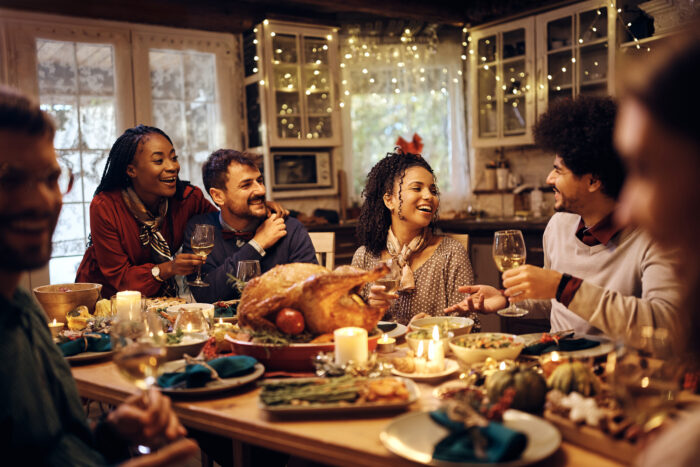With the holidays upon us, it can be challenging and overwhelming navigating the holiday foods while working on your nutrition goals. However, after reading this article, you will be able to build a balanced plate and learn tips and tricks to navigating this holiday season without the guilt.
Building a Balanced Plate
When building your plate, it is important to incorporate each of the food groups below to ensure your plate is balanced and you feel satisfied after the meal.
Carbohydrates
When selecting your carbohydrates, select complex carbohydrates versus refined carbohydrates (i.e., white bread/pasta, sugary drinks, baked goods). This is because complex carbohydrates contain fiber. Fibrous foods take longer for our bodies to digest, so they help control our blood sugars and keep us full for longer. Examples of complex carbohydrates include whole grain breads/pastas, starchy vegetables (i.e., potatoes, corn, peas), beans, brown rice, and fruit.
Aim for no more than ¼ of your 10- inch plate filled with complex carbohydrates to help keep your blood sugar in a safe range.
Fat
When consuming fat, incorporate heart-healthy unsaturated fats (i.e. nuts, seeds, olive oil, avocados, fatty fish) versus saturated fat (i.e. creams, butter, beef, pork, coconut oil). Substitutions will be helpful for this, and you can get quite creative too!
- Use non-fat plain Greek yogurt instead of sour cream
- Olive/avocado oil instead of butter
- Evaporated low fat milk instead of cream
- Sliced almonds for an added crunch instead of fried onions or bacon bits to top a salad
Protein
Try selecting more fish and skinless poultry because they are lower in saturated fats compared to red meat and pork. Aim to fill ¼ of your plate with lean protein.
- When cooking your protein, try to bake, sauté, grill, or broil protein instead of deep frying
- If you still want a crispy texture, try air frying your protein instead
Non-Starchy Vegetables
Let this be your new friend this holiday season! These would include any vegetable besides peas, potatoes and corn because they are more of a carbohydrate source. Non-starchy vegetables are low in calories, high in fiber and lower in carbohydrates compared to breads, rice and fruit. At your next holiday party, try incorporating at least 50% of your plate to be filled with non-starchy vegetables.
Beverages
Be careful to limit or avoid beverages that contain high amounts of sugar. Try to stick to water or sugar-free beverages when available. If water is boring, try a fresh herb and fruit- infused water or drink sugar-free sparkling water. Put your drink in a fun glass, with a garnish to make it feel special. When drinking alcohol, do so in moderation (1 alcoholic drink for women and 2 alcoholic drinks for men per day).
4 More Tips for Success During the Holiday Season
Don’t Arrive Hungry
If visiting a family or friend’s house for a holiday meal, don’t arrive hungry, because it may cause you to overeat at your next meal. Try eating a small snack (100-200 calories) before you arrive to the event as it will be easier to make better food decisions. Examples of snacks include small apple with 1 tablespoon of peanut butter or 1 cup of raw vegetables and 2 tablespoons of hummus.
Balance and Moderation
Can you still eat your favorite foods during this holiday season? Yes! The key is balance and moderation. Balance means if you are going to have a high calorie entree, then add a lower calorie side dish. For example, if pasta is your entree, add a large salad or roasted vegetables for your side. Additionally, if you know you will be eating dessert, load up on the non-starchy vegetables and lean protein for your dinner. There are no “bad” foods – balance and moderation are key.
Plan Plan Plan
Worried about the selection of food at your next holiday party? If you are going to a holiday potluck, make sure to bring an item with you that you enjoy and is nutrient dense. An example can include balsamic glazed roasted Brussel sprouts with pecans. By doing this, you will have at least one nutrient dense dish that you can enjoy. However, don’t deprive yourself from other items. Depriving yourself can lead to increased cravings and overeating later- just do so in moderation.
Don’t Forget about Movement
No need to run a marathon to see the benefits – even a 10-15 minute walk after a meal can be beneficial to control blood sugars. Don’t move alone, get your family and friends onboard! Throughout the holiday season, find little ways to increase your movement. This can mean parking further away from the stores, taking the stairs versus the escalator, setting a daily walking goal by using a pedometer, and using the commercial breaks to complete exercises at home (i.e. lunges, walking up and down stairs, riding stationary bike).
—
Avance Care is offering a virtual 4-week holiday mini-series that will provide strategies on how to savor the season and stay on track with your wellness goals. This class will cover topics such as:
- Eating a balanced plate
- Being mindful of calories
- Navigating healthy choices at holiday parties and dining out
- Learning when it’s okay to say no
- Holiday recipe swaps and resources
- Lighter alcohol options
- How to manage holiday stress
- Incorporating activity into your day
- And More!
Don’t let the holidays throw you off balance—empower yourself with the tools to enjoy the season, guilt-free!
Classes will be held virtually on Tuesdays, 12:30 PM – 1:00 PM:
- November 19
- November 26
- December 3
- December 10
Most insurances cover this class! Visit here to register.
How to register:
- Click the link above
- Select “View Forms”
- Fill out your contact information
- Group Type: Mini Series – 4 Week Series
- Start Date: November 19th




